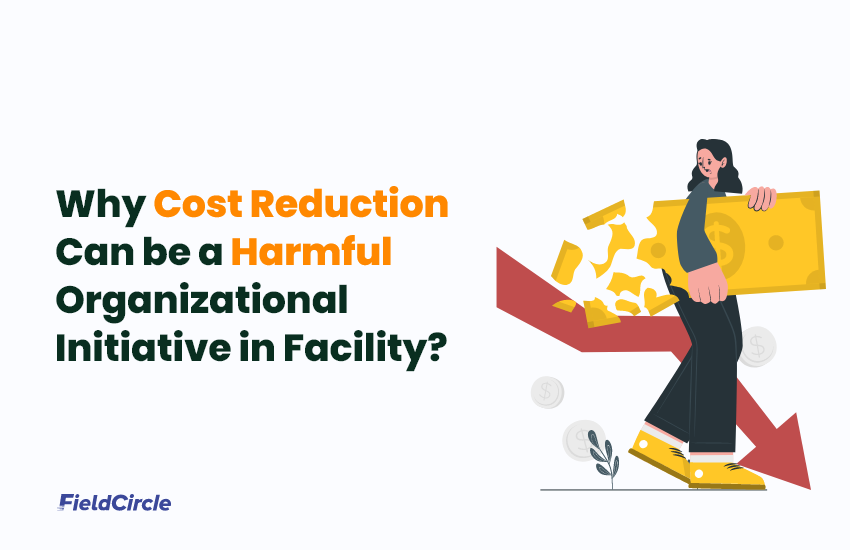Can Cost Reduction be a Harmful Initiative for Facilities? The Risks and the Mitigation Tactics

In today’s economic climate, reducing and optimizing costs is not just a necessity but is critical to the survival of a business. However, it’s essential to carefully evaluate any cost-cutting measures before putting them into action, as they can lead to unintended consequences. A survey by McKinsey proposes that 79% of companies cut costs during the global economic crisis, but only 53% of executives believe it helped their companies survive.
So, the questions remains- is it really beneficial to focus so much on cost optimization and cost cutting measures?
Let us explore this with a real-time scenario in value engineering, where downsizing during construction can lead to increased spending elsewhere. For instance, buying less energy-efficient windows may result in higher energy bills and cause the HVAC system to struggle during peak design days. Additionally, design changes could compromise compliance with fire safety codes or unintentionally undermine security. In a worst-case scenario, an expenditure could lead to a company losing business.
Many finance and procurement teams seek to lower expenses in today’s competitive landscape. However, it’s crucial to adopt a strategic approach to curtailing costs. Hasty and excessive measures may jeopardize the company’s long-term success. In the following section of the blog, we will explore the consequences and risks of cutting facilities management costs. A list, curated from our discussion with facilities leaders across industries.
Potential Risks of Implementing a Wrong Cost-Cutting Strategy
Did you know many organizations lack clear measures of success for their cost management policies, with over 50% falling into this category? Additionally, only 43% of leaders can achieve cost-saving targets during the first year of cost reduction. Furthermore, a mere 11% of organizations can sustain cost savings for three consecutive years, according to a report by Gartner.
Scaling down may seem wise in the short term, but it can harm an enterprise’s long-term sustainability and competitiveness. Below are some of the possible adverse outcomes of cost optimization measures that are not carefully planned and executed:
1. Decreased Quality:Cost-cutting measures that compromise product or service quality can lead to customer dissatisfaction, loss of loyalty, and a tarnished brand reputation. For instance, a facility management company reduces janitorial services in a corporate office building to cut costs, leading to complaints from tenants, reduced contract renewals, and difficulty in attracting new clients. To prevent such outcomes, it becomes essential to strategically manage service contract expectations and performance metrics, ensuring cost-efficiency does not come at the expense of service quality.
2. Loss of Talent: Cost-cutting strategies that involve layoffs, reduced benefits, or compensation cuts can lead to the departure of valuable employees, resulting in a loss of knowledge, skills, and experience. For example, an ill-conceived cost-cutting strategy may include employee layoffs and reduced benefits, leading to the loss of experienced technicians. This not only affects service quality but can also have implications for retail loss prevention, as understaffed or undertrained teams may miss critical maintenance or security issues. The result can be longer response times for maintenance requests and more frequent subcontracting, ultimately increasing costs.
3. Operational Disruption: Cost-cutting strategies that fail to consider the potential consequences can be disruptive to essential business processes, leading to inefficiencies, delays, and reduced productivity. For example, a business may decide to reduce costs by cutting back on preventive maintenance for HVAC systems in a hospital. This decision can result in frequent system breakdowns that affect temperature control in critical areas. As a result, surgeries may be delayed, and patient care may be compromised, leading to operational disruptions and reputational damage.
4. Regulatory and Compliance Issues: If an organization cuts costs without taking legal and regulatory requirements into account, it may face penalties, fines, and legal liabilities. For instance, a facility management company failed to update its safety protocols according to new regulatory requirements. As a result, during a surprise inspection, the company was fined heavily for non-compliance, which could have been avoided by making proper adjustments. The decision to reduce costs ultimately led to significant financial liabilities.
5. Employee Morale and Engagement: Implementing cost-cutting measures that are unpopular can have a negative impact on employee morale, motivation, and engagement. This can lead to decreased productivity and increased staff turnover. For instance, an organization may decide to implement a cost-cutting strategy that involves a freeze on salary raises and the removal of performance bonuses. Such measures can make employees demotivated and less engaged in their work, resulting in reduced productivity, higher turnover rates, and difficulties in providing quality services.
6. Short-Term Focus: Excessive emphasis on reducing costs in the short term may have negative implications for long-term sustainability and competitiveness. It may lead to neglect of essential investments in research and development, technology, and employee development. For instance, a company may decide to postpone necessary technology upgrades in its maintenance processes to save money in the short term. However, over time, outdated systems can impede efficiency and cost-effectiveness, ultimately affecting their long-term competitiveness in the industry.
7. Supply Chain Disruptions: Cost-cutting measures can affect the supply chain, causing disruptions and delays in the availability of critical materials or components. A facility management firm reduces costs by seeking cheaper suppliers for essential cleaning products. However, the new supplier experiences production issues, leading to delays in product deliveries. As a result, cleaning schedules are disrupted, and facilities become unsanitary, leading to client dissatisfaction and damage to the company’s reputation.
8. Reputation Damage: When cost-cutting strategies are viewed as unethical or harmful to stakeholders, they can have a negative impact on an organization’s reputation and public image. For instance, a facility management company decides to outsource maintenance services to an overseas provider known for unethical labor practices. As soon as this information becomes public, the company faces significant backlash from clients and the public, which severely damages its reputation.
9. Missed Growth Opportunities: Focusing solely on reducing costs may cause an organization to overlook growth opportunities and market expansion that require strategic investments. For instance, a firm that concentrates only on minimizing operating expenses may neglect investments in technology and staff development. As a result, they miss out on opportunities to expand into new markets or offer innovative, high-value services that could have boosted their growth and competitiveness.
10. Financial Instability: Cutting costs indiscriminately can lead to financial instability, making weathering economic downturns or unexpected expenses difficult. A facility management company indiscriminately reduces operational expenses without assessing the potential risks. When a sudden economic downturn occurs, they lack the financial reserves to weather the storm, leading to financial instability and potential insolvency.
11. Innovation Stagnation: When an organization implements drastic cost-cutting measures, it may hinder its ability to innovate and adapt to changing market conditions. For instance, a firm decides to reduce its research and development budget in order to save money. However, this can inhibit its ability to keep up with evolving market trends and client demands, leading to a stagnation that puts them at a competitive disadvantage. Meanwhile, their competitors may offer more advanced and cost-effective solutions, thus gaining an edge in the market.
So, How to Mitigate the Risks of Wrong Cost-cutting Strategy?
Mitigating the risks of executing the wrong monetary efficiency strategy is crucial for an organization’s long-term health and success. Here is a list of tactical steps to help you mitigate these risks:
– Comprehensive Risk Assessment:
Identifying and evaluating all possible risks that may arise from cost-cutting measures is crucial. To better understand each decision’s potential outcomes, a comprehensive risk analysis should be carried out. As part of effective maintenance budget planning, a company should conduct an in-depth risk assessment and comprehend that reducing the maintenance budget for critical infrastructure in a facility could result in operational disruptions and legal liabilities.
– Prioritize Cost Reductions:
It is crucial to prioritize facilities management cost reduction strategy that have the most negligible impact on service quality, employee morale, and regulatory compliance. The focus should be on areas where savings can be achieved without compromising essential functions. For example, suppose a company determines that reducing the frequency of landscaping services in a commercial complex has a minor effect on client satisfaction compared to other cost-cutting measures. In that case, they can focus on reducing the frequency of landscaping services rather than cutting more crucial services such as security or HVAC maintenance.
– Engage Stakeholders:
It’s essential to involve key stakeholders such as employees, clients, and regulatory bodies in decision-making. Their insights can provide a broader perspective on potential consequences and alternative cost-cutting strategies. An organization planning to reduce the number of on-site staff for a large corporate office building should engage with building occupants and clients to understand their concerns. By doing so, the company can opt for a phased reduction, allowing them to maintain client satisfaction while optimizing staffing.
– Focus on Efficiency:
To boost operational efficiency, it’s essential to adopt lean processes and automation. By doing so, you can reduce costs without compromising the quality of your services. For instance, a company can implement a facility management platform to streamline maintenance processes. By automating work order generation and resource allocation, it’s possible to enhance efficiency and minimize operational expenses while maintaining the desired level of service quality.
– Long-term Perspective:
It’s important to avoid excessive short-term cost-cutting at the expense of long-term sustainability. You should balance cost reduction with necessary investments in technology, infrastructure, and service improvements. To achieve this balance, a facility management firm can create a capital reserve fund that is dedicated to strategic investments in facility improvements and technological upgrades. This approach ensures a competitive advantage in the industry and helps to maintain long-term sustainability.
– Compliance and Legal Guidance:
Ensuring that all cost-cutting measures comply with legal and regulatory requirements is crucial. Seek legal guidance whenever necessary to prevent any legal issues. For example, suppose a service provider is contemplating reducing fire safety inspections to save money. In that case, it is essential to consult with legal experts to ensure they remain compliant with all relevant fire safety regulations. This consultation will assist them in avoiding any legal issues while also allowing them to reduce non-compliance costs.
– Continuous Training and Development:
Invest in employee training and development to enhance their skills and adaptability. Well-trained staff can contribute to operational efficiency and innovation. A facility management company can invest in ongoing training for its technicians, making them proficient in new, cost-effective technologies. This investment will enhance their skills and adaptability, leading to greater efficiency in maintenance operations.
– Risk Management Framework:
Establish a comprehensive risk management framework that includes risk identification, assessment, mitigation, and monitoring. Ensure that risk management becomes an integral part of decision-making processes. Suppose a firm establishes a risk management framework, which includes regular risk assessments and mitigation strategies. In that case, it becomes a standard part of their decision-making process, ensuring that risks are proactively identified and managed.
– Benchmarking and Vendor Negotiation:
Benchmark service costs against industry standards and negotiate with vendors for better terms. Explore opportunities to maintain quality while reducing expenses. A business that conducts a benchmarking study to compare its maintenance costs with industry standards can negotiate more favorable terms with suppliers and contractors, securing cost reductions without sacrificing service quality.
Conclusion
When a company experiences a decline in revenue, the knee-jerk reaction may be to cut costs. However, it is crucial to be mindful of the message conveyed to your resources and customers. It is vital to avoid giving the impression that the company is struggling and that the ship is sinking. Instead, focus on areas where you can add significant value for both your existing and potential customers.
While monetary efficiency strategies can be effective if done correctly, it is imperative to ensure that they do not come at the expense of workforce or customers. A company that prioritizes cutting costs without considering its impact on stakeholders runs the risk of becoming irrelevant in the long run. The most successful companies do not compete solely on price or lowest cost but rather on delivering exceptional value to their customers—especially in areas like customer service in facilities maintenance, where timely communication, issue resolution, and reliability directly influence client satisfaction and long-term partnerships.
To achieve this goal, focusing on delivering exceptional value to your customers is essential. By doing so, you can foster employee and customer loyalty, which can help you reach new heights. FieldCircle can help you streamline your operations and provide an optimal facility experience. Feel free to get in touch with us to learn more about how we can help you in this regard.


